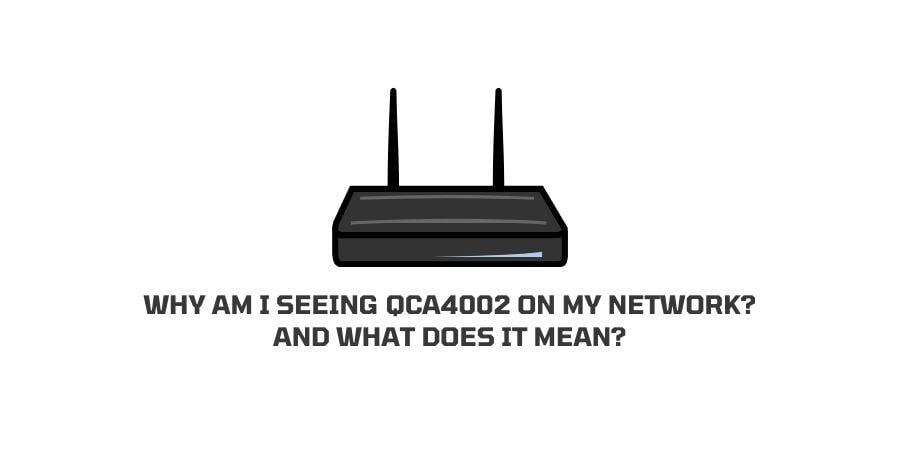
If you are using a Wifi connection to get on the internet, you must be aware of the fact that you will see various codes on your network to indicate many errors.
Different error codes tell you what exactly is wrong and then you can get on your toes to solve that problem before you can connect to the internet.
But what is QCA4002? Is this an error? Is this something that needs your attention, or is it something that you should be happy about?
In this article, we will explore your questions like Why am I seeing QCA4002 on my network? And what does it mean? We will also discuss if you need to do something about it. So let us move to the next sections for the answer.
What is QCA4002?
To understand the threat and if there is any, we need to understand what is QCA4002. In layman’s terms, this is a smart Wifi network that is used by the physical objects around your house that either use the Wifi for basic or enhanced functioning.
It is a really great feature for the advanced age where you can use advanced technology in the regular monotone objects around your house like the lights, refrigerators, and even cars.
The special tool that helps these devices to communicate over the internet, is QCA4002.
Is there an issue If You Get QCA4002 On My Network?
Now that we have understood that QCA4002 is only used for the Internet of Things (IoT) and not for individual connections, we can be relieved that if you see this, no person is trying to hack into your Wifi connection for unauthorized usage.
But what can be true if you have no device that is this advanced to use the QCA4002 tool, someone else’s device might be trying to connect to the internet services through your Wifi.
This is almost the same as some people using your Wifi for their use because ultimately, it is your data plan that will be consumed.
If you are facing a problem with the unknown QCA4002 connection showing up on your Wifi devices, there are certain steps that you can take to make sure no unauthorized device is accessing your Wifi.
Let us explore them in the next section where we also look for potential solutions to this problem.
What should you do If You Get QCA4002 On My Network?
In case you do not have a device that uses the internet connection to function, then it is fairly obvious that it is not your device that is using the Qualcomm module to connect to the internet. Even if you do have such a device, how can you make sure that the connected device is yours?
Let us see what can help you identify.
Fix 1: MAC Addresses
When you are suspicious of an unauthorized connection on your Wifi, the first thing that can be of great help is looking through the MAC address of the device and then matching them on the internet to see if you own the device.
When you access the devices connected to your Wifi and see this QCA4002 connection, click on it and look under the properties section. Here you will be able to find the MAC address of the connected device.
When you finally get the MAC address, launch Google and search for the MAC address just obtained. Now you can see the manufacturer of the device and then gather if you own a device from the manufacturer and is it using the internet of things to provide you with some extra features or updates? If the device is yours, you do not need to worry and if it is not yours, you can kick the connection out of your Wifi.
Fix 2: Make a list
If you have more than one device that might be using the internet of things, then you will see many MAC addresses simultaneously on the Wifi device list with the same module that is QCA4002.
In this case, it is very easy for a device to creep up on your connection without you taking a note of it. It is very easy to slip up when you do not check the Wifi for the connected devices regularly and have also taken the QCA4002 module to be a common feature on your Wifi device list.
So, how can you make sure that there is no uninvited guest on the Wifi sneaking in a hefty update and racking up your bill?
Make a list. You need to take all the device connections labeled with the Qualcomm module on your Wifi connection and note them down.
Now check for the MAC addresses of each of the connected devices and make sure that you have the device on your list.
If you have a MAC address that does not match a device on your list, there is your black sheep and you can kick it out.
Fix 3: Disable the QCA4002 module altogether
If you do not have any device that might be using the Qualcomm module, then you have no reason for permitting the QCA4002 module on your Wifi.
In this case, no need for the hard labor of investigating the MAC addresses. You can just simply disable the permission for this particular module and you are all set.
Conclusion
Qualcomm is a great technology company and has led to many advancements in the internet and connectivity sector. QCA4002 module is one such innovation from the company that helps you connect your smart devices to the internet with ease.
It is a great feature if you own smart devices but if you do not own any and still see this module on your Wifi network, some device is stealing your data.
In this article, we have made sure to include the identification markers of an unauthorized connection on your Wifi and also included the ways to kick them out with minimal effort.
You should not only kick unauthorized connections to save your data, but also take care of devices leaving safety gaps on your Wifi.
We hope that this article helped provide insights. Keep reading for more informative articles.
Like This Post? Checkout More
